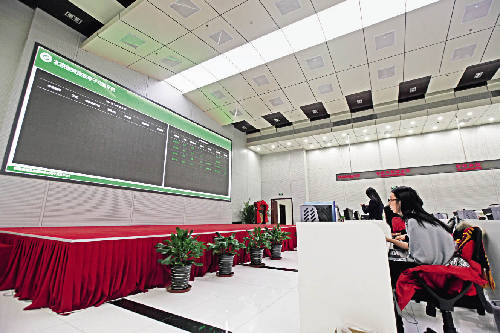Carbon Trading: Market Mechanisms
|
 |
| The carbon trade hall at Beijing Environment Exchange |
For example, Shanghai adopts benchmarking for electricity, aviation, airport and harbor companies, and grandfathering for other industries and public construction. Beijing uses grandfathering for existing facilities, namely their average annual emissions from 2009 to 2012, while benchmarking is used for new projects. “If a company performs well in emission reduction, the quota will be surplus, and they could sell it in the market and acquire capital.” Wang said. During the annual clearance, if a company is found to be surpassing its quota and not purchasing new quotas, it would probably be fined three to five times the average price in the carbon market.
In the last four months, Wang discovered a phenomenon: the more dynamic aspect of the market is the voluntary organizations, which benefit from price fluctuations. Qian Guoqiang believes that carbon trading has a financial nature, and moderate speculation is normal only if the supervision works effectively. “One of the benefits around speculation lies in that it can introduce large amounts of money into the market, while reducing risk by spreading one person’s risk to every stakeholder,” he explained. “If the investors and companies can make money in the carbon market, they will get ahead. It is such an environment that the carbon trading market aims to create.”
National Carbon
Market Anticipated
Currently, the five pilot markets in operation are independent, with their own registration systems and trading platforms. However, to allow market mechanisms to play a bigger role, they must break out of their closed systems and establish a unified, open national market. Su Wei told China Today that the central government is studying the experience of the seven pilot markets to establish a national market, striving for completion in the 13th Five-year Plan period (2016-2020).
For policy and technological reasons, it is more practical to construct a new national market than to promote the mode of one pilot market or to increase the number of pilot markets. The seven pilot markets have various regional characteristics, such as the financial center of Shanghai, industrialized Guangdong and Shenzhen, and less-developed Hubei and Chongqing. With different economic development levels, industrial distribution and company scales, these pilot markets had to fully consider local conditions during preparations. They have shown innovativeness and flexibility when establishing trading mechanisms, rules and accounting systems, which provide useful experiences, but also demonstrate many differences between their systems.
For example, concerning the threshold for regulated companies, Shenzhen set a standard at 5,000 tons of carbon emissions a year, and Beijing, 100,000 tons; while Shanghai and Guangdong first selected several industries and then set standards. The detailed trading rules also differ. In Shenzhen and Tianjin, after verification, individuals are allowed to participate in trade; while in Guangdong and Shanghai only regulated companies are allowed to trade. In addition, in Beijing and Tianjin, besides online trading, offline negotiation and trading are also permitted.
Therefore, Su Wei says, it will be difficult to interconnect different markets in the short term, owing to complicated issues involving policy and technology; and there is no point in increasing pilot markets, as it would create more small independent markets, and waste resources.
Thus far, the NDRC has invited experts to research the total control targets of China’s carbon trading, and published accounting and reporting guidelines for key industries’ greenhouse gases. It plans to strengthen basic data collection, and implement a greenhouse gas emission reporting system for key companies nationwide, so as to confirm the scope of regulated companies, and formulate a reasonable quota allocation plan. In addition, the NDRC will establish a unified registration system and third-party verification system in the country, draw up supervision rules and figure out risk-prevention methods. Meanwhile, the commission is also researching the feasibility of carbon futures, and pondering over the sustainable and healthy development of the market.
“A large unified market will inject new vitality into carbon trading,” Wang Yang said. “It’s no problem to operate under the new standards. Beijing will adapt better than other regions as we have accumulated several years of experience.” In January 2014, the CBEEX, collaborating with carbon trading organizations in 15 provinces and cities, launched the China Environment Trading Organization Cooperation Alliance, to strengthen exchange and cooperation among markets. Carbon trading represents a vast, new market. Practice and cumulative experience are needed to safeguard the sound development of the market.
- Are You Ready to Perform?
- Beijing’s Green Courtyard
- China’s CSR on the Global Market Fast Track – An Interview with Xu Zongxiang, vice president of China South Locomotive & Rolling Stock Corporation Limited (CSR)
- China’s Changing Development Pattern
- China Accelerates Transformation of Its Economic Development Model
